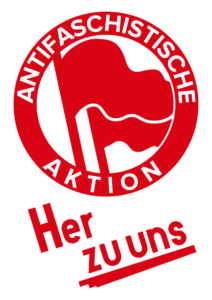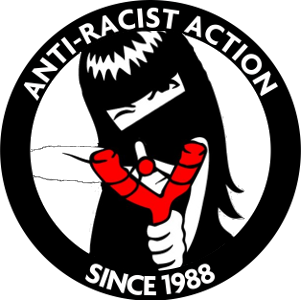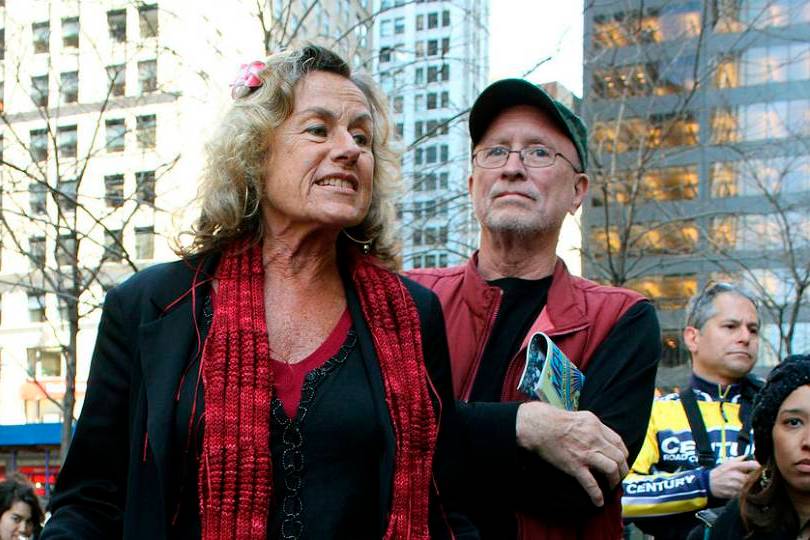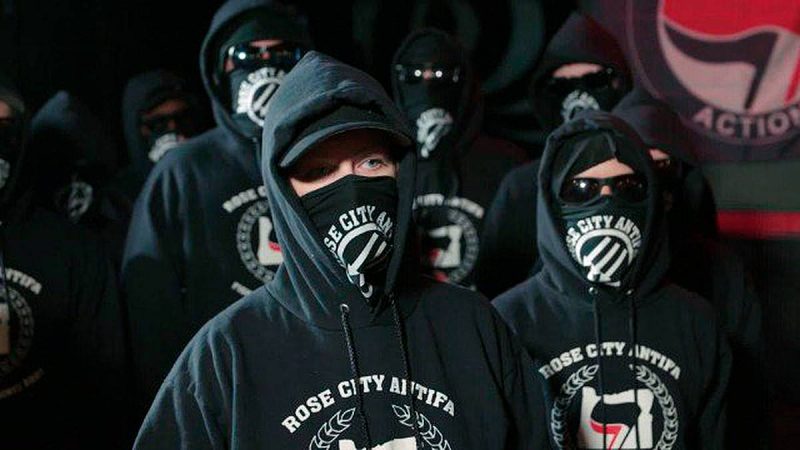1
…the US security services physically eliminated not the most dangerous figures among the radical anti-war movement and the Black Panthers, but those who were trying to move their organizations in a more respectable social and political direction.
The wave of street violence that has become the hallmark of the strange US election campaign of 2020 brought two movements to the forefront that previously enjoyed only “wide recognition in narrow circles” in the US: Black Lives Matter (BLM) and antifa. We reviewed the genesis, aims, and structural features of the former in our article, “America in Flames – Whose Lives Matter?“ in issue 396 of the Essence of Time newspaper. It is now time to turn our attention to the antifa movement in its American version.
The term antifa first entered the common lexicon in the United States in 2017. First, members of the movement participated in the riots in Washington, DC, which broke out in response to Donald Trump’s inauguration. This was followed by the trashing of a venue at the University of California, Berkeley, where Milo Yiannopoulos, a rather strange far-right homosexual, who had briefly become very popular among the so-called alt-right in the United States, was to speak. On August 11-12, there were clashes in Charlottesville, Virginia, between the Unite the Right protesters and their leftist opponents. It is worthwhile to briefly recount these events.
On August 11-12, 2017, two groups of activists clashed in the town of Charlottesville, flocking from all over the country. First, a Unite the Right rally was announced in the city, and various leftist organizations began planning counter-protests and clashes in response. The formal reason for the far-right rally (including members of the Ku Klux Klan and the US National Socialist Movement, as well as some less notorious and odious groups) was the decision of the Charlottesville City Council to remove the monument to General Robert E. Lee, commander-in-chief of the Confederate Army, from Emancipation Park, which had previously borne his name.
On August 11, the far-right held a torchlight procession on the University of Virginia campus, during which there was a relatively minor clash between right-wingers and about thirty counter-protesters. The main clashes took place on August 12, directly in and around the park.
The images were quite spectacular and memorable for many. The two opposing sides looked like rather motley bunches, but each had a more organized and combat-ready core. Among the right-wingers, the most organized were members of local unofficial “militias”, identifiable by their military-style uniforms and assault rifles (which, however, were not used during the clashes for their intended purpose). The fighting core of the counter-protesters wore all black and covered their faces. Small groups of people dressed this way rapidly approached the right-wingers and carried out quick physical attacks, both with their bare hands and with improvised objects, and then disappeared back into the crowd.
At the beginning of the clashes, there was practically no police barrier. The police appeared and began to separate the sides much later. In those two days, thirty-eight people sought medical attention with injuries, and three died (the crew of a crashed police helicopter and a woman from a group of counter-protesters who was hit by a sports car with a member of the far-right behind the wheel).
US President Donald Trump came under media fire at the time for not forcefully distancing himself from all Unite the Right protesters, instead condemning “violence from both sides.” This condemnation included multiple calls by both Trump and his former attorney general, William Barr, to declare the antifa movement a terrorist organization.
How much practical sense does this move make?
Trump’s opponents, both in the Democratic Party establishment and far from it, repeat like a mantra phrases like “antifa is not an organization, but an idea,” and that only fascists can be against antifascism.
In order to understand how valid the claim is that antifa is not an organization, it is necessary to look at the history of the movement. It so happens that at the moment, the history of the antifa movement is most fully and systematically described in English by an overt antifa apologist, historian Mark Bray, who works at Rutgers University in New Jersey and defended his dissertation there on the anarchist movement in Spain in the early twentieth century. Bray himself does not consider himself a member of antifa, but he was previously involved in the Occupy Wall Street movement. Bray’s major work, Antifa: The Antifascist Handbook, came out in 2017, responding directly to the information wave that emerged in the American press surrounding the movement.

Bray begins by making it clear that the contemporary antifa has no direct organizational relationship to the antifascist associations that existed in the first half of the 20th century, including the German Antifaschistische Aktion, a modified version of whose symbolism today’s antifa uses all over the world.
The current movement, with its characteristic tactics, emerged in the early 1980s simultaneously in several Western European countries among a subculture of punks who originally gravitated toward anarchism. It was prompted by the emergence of a neo-Nazi current among skinheads.
For their confrontation with far-right skinheads, the European punk anti-fascists chose the so-called “black bloc” tactic. This tactic involves an organized physical attack on the opponent’s gatherings by groups wearing similar black sportswear and covering their faces to make individual participants more difficult to recognize.
It is because of these tactics that contemporary antifa members consider themselves the successors of the leftist militant groups that opposed Hitler and Mussolini’s stormtroopers and their less successful followers in other Western countries in the first half of the 20th century. Contemporary antifa apologists believe that the history of the rise to power of the fascists in bourgeois-democratic Italy and Germany proves that in opposing fascist organizations one cannot limit oneself to working on the respectable social and political field, but that one must provide violent opposition against emerging fascist organizations at a very early stage. In their opinion, the main mistake of the Antifaschistische Aktion is that it was formed too late.
It is worth noting one very important ideological difference between the new Antifa and the old one. The Antifaschistische Aktion consisted mainly of members of the German Communist Party and socialists who joined them. This is what its emblem symbolizes – two red flags. By replacing the red banners in its emblem with black and red, and in some cases even with only black banners, the modern antifa unequivocally declares its anarchist orientation.
In his description of the new European antifa, Bray highlights the ideological conflict that emerged in the early 1990s between the two main European antifa associations: the German Autonome Antifa (M), or simply AA (M), and the British Antifascist Action (AFA).
AA (M) was initially formed predominantly by people with middle-class backgrounds, with significant involvement of third-wave feminists (so-called Fantifa), and sexual minority rights activists, while the British AFA groups consisted mainly of working-class youth and were more traditionally left-wing in orientation. The German antifa accused their British counterparts of “class reductionism,” considering the part of their agenda that unites them with current liberal human rights activists to be more important. The split between the more traditional leftists and the so-called intersectionalists (i.e., those who prioritize the interests of endlessly multiplying minorities over the class approach) continues to this day, with the vast majority of antifa supporters in the United States representing the latter tendency.
A homegrown antifa movement in the United States emerged relatively late – in 1987 in Minneapolis, Minnesota, also among punks, and was initially influenced by the British AFA by virtue of a common language. The Americans, making adjustments both to the nature of extreme right-wing organizations in the United States and to the general anti-communist climate prevailing in the country, first called themselves not anti-fascists, but anti-racists and created the ARA (Anti-Racist Action), while adopting elements of “black bloc” tactics.

With the spread of the Internet, the ARA developed another distinctive tactic: seeking out members of far-right groups online and then publishing their personal data in the open, often resulting in the loss of their jobs and social standing. The Internet also allowed members of individual autonomous cells to talk, exchange experiences, and coordinate larger-scale actions.
As it spread across the United States, the ARA began quite rapidly to drift ideologically away from the British AFA. This was due to “cross-pollination” with older US associations working to oppose the Ku Klux Klan and other far-right organizations, as well as with older pseudoleftist organizations. This includes splinters from organizations related to the 1960s anti-war movement, including from Students for a Democratic Society and former members of the domestic terrorist organization, the Weathermen.
The first organization in the United States to use the antifa name, Rose City Antifa, emerged in 2007 in Portland, one of the main centers of American anarchism. The new name soon spread across the country, not only among newly formed groups, but also among old ARA members. In 2013, an announcement appeared on the ARA website about the creation of what would become the largest antifa coordination network in the United States, the Torch Antifa Network. Thus, we can say that the core of modern American antifa is the ARA, which has changed its name and attracted young people.
Long-time members of antifa cells who agree to talk to the press usually say that they are members of various other pseudoleftist and anarchist associations. They describe their participation in antifa as part of a broader circle of social and political work. Such activists can be members of Black Lives Matter and various kinds of organizations promoting the LGBT agenda, or they can be trade unionists or members of various pseudoleftist or anarchist midget parties. In this sense, antifa in the United States is a network rather than an organization with a rigid hierarchy.
In earlier periods, the existence of ARA and Antifa associations was often situational in nature. Former and current members often say that their cells were formed after the left-wing anarchist community in a city or even a neighborhood became aware that a particular far-right organization had emerged in their midst. The activists would get together, confront that particular group, and after that group waned, the antifa cell would disband, because its participants would return to other activities.
The situation changed dramatically after the election of Donald Trump as president of the United States in 2016. A large number of young people who came to oppose the “fascist in the White House” began to join the ranks of antifa cells.
Does it turn out, then, that antifa in the US is really, as Trump’s critics say, not an organization, but an idea? Not entirely. Of course, it is a network structure. But it is a network structure that is capable of large actions on a federal scale. The same previously mentioned clashes in Charlottesville were mobilized events for both sides, and the ranks of the counter-protesters included Rose City Antifa, based in Portland, on the other side of the country.
Several networks exist in the US that aim to coordinate antifa. The largest of these is the Torch Antifa Network, which grew out of the ARA. The network holds annual conferences, as the ARA did before it. Some of its speakers include invited guests. For example, the list of speakers at the 2011 ARA conference included Bill Ayers and his wife Bernardine Dohrn, former founders of the pseudoleftist terrorist group called the Weathermen, who became professors of law after the organization disbanded.
Recall that the publication in 1971 of materials relating to the FBI’s COINTELPRO program, which revealed the infiltration by US intelligence officers into the ranks of the Weathermen and Black Panthers without court authorization, led to US courts refusing to consider the covert intelligence as evidence for the prosecution. This allowed even the leadership of the Weathermen to avoid serious prison sentences. It is also worth recalling that the same COINTELPRO documents show that the US intelligence agencies physically eliminated not the most dangerous figures among the radical anti-war movement and the Black Panthers, but those who were trying to turn their organizations in a more respectable social and political direction. We wrote about this in the article “Trotskyism in the USA, or the Century of Political Vampirism” in issue 338 of the Essence of Time newspaper. Considering the extremely strange circumstances under which the materials on this program were made available to the press – under circumstances very much resembling an orchestrated leak – one can suppose that the purpose of the leak was to cover up a much closer relationship between the secret services (the FBI and CIA) and the structures they were allegedly investigating.

So, the former leaders of the structure, already familiar to us from the COINTELPRO story, who escaped prolonged imprisonment and then became professors of law in Chicago, made an appearance at the ARA conference. Where else have they been seen?
The spouses Ayers and Dohrn were active in the Occupy Wall Street (OWS) movement in New York. We remember that Leah Hunt-Hendrix, a good friend of BLM and founder of the Solidaire Foundation, who had previously worked in the Middle East during the Arab Spring, was also involved in the movement.
The OWS movement itself was also, by and large, an amorphous collection of smaller groups with very different tactics. Among these groups, there was also a group of “black bloc” anarchists. These “black bloc” activists came under heavy criticism from prominent OWS members, such as journalist Chris Hedges. Hedges called the black-bloc anarchists “a cancer on the Occupy movement,” accusing them of discrediting both OWS and the leftist movement as a whole. The journalist suggested that associating the American left with Black Bloc violence could lead to both state persecution of the left and further radicalization of extreme right-wing movements. Hedges was joined in his criticism by the prominent American leftist intellectual, the linguist Noam Chomsky, who called antifa “a gift to the right.”
Since their emergence in the United States, the Black Bloc groups have gone far beyond violent confrontations with far-right street groups, the reason for which they originally began using these tactics. They began to attack perfectly peaceful gatherings of Republicans and to simply smash up urban neighborhoods indiscriminately in the total absence of any opposing street forces, as the riots after George Floyd’s death demonstrated.
Antifa apologist and historian Mark Bray justifies this with the challenge of “pinstripe fascism.” That is, fascism dressed up in the clothes of “respectable political discourse.” At the same time, Bray himself advocates the broadest possible interpretation of fascism, in which there is a place for such increasingly blurred concepts as “white supremacy,” “misogyny,” “homophobia,” and so on.
This extremely broad interpretation of fascism provides grounds for attacks on assemblies of Christians protesting against abortion, or even for mass riots – for if the United States as such suffers from “systemic racism,” then the destruction of storefronts can be presented as a protest against this racism. All the while, nothing remains from Georgi Dimitrov’s definition of fascism, which guided the albeit problematic but infinitely healthier old European antifascist movement. It is proposed that those who speak Dimitrov’s language now be called “class reductionists.”
Where could this all end up?
At the VII Congress of the Comintern, Georgi Dimitrov gave the following definition of fascism, “Fascism is the open terrorist dictatorship of the most reactionary, most chauvinistic and most imperialist elements of finance capital…Fascism is not a power standing above class, nor government of the petty bourgeoisie or the lumpen-proletariat over finance capital. Fascism is the power of finance capital itself. It is the organization of terrorist vengeance against the working class and the revolutionary section of the peasantry and intelligentsia. In foreign policy, fascism is jingoism in its most brutal form, fomenting bestial hatred of other nations.”
Dimitrov gave this definition in 1935. Of course, Dimitrov’s definition cannot be elevated to an absolute. Subsequent history, including the defeat of Western European antifascists, showed that this old understanding of fascism was incomplete. And this incomplete understanding prevented those, I repeat, infinitely healthier antifascists to fully mobilize against the absolute evil that sought to enslave humanity and destroy humanism.
But Dimitrov was right in seeing that fascism contains an internal actor that implements it. And in the first approximation, this actor is indeed seated within financial capital, although it is not entirely limited to it.
Since then, we have seen one great innovation: the metamorphosis, or mutation, of financial capital, which has become transnational. This mutating capitalism is engaged in the destruction of nation states and their foundation of values. With the changing face of chauvinism in modern Western society, where the traditional family and classical culture have been declared the main enemy, it has become appropriate to speak of so-called liberal fascism.
Nevertheless, among the allies of this liberal fascism are the more familiar forms of fascism that the world encountered in the time of Dimitrov, such as the Banderite rule in Ukraine. Incidentally, members of the so-called Ukrainian antifa not only did not tangibly oppose the Maidan; but on the contrary, they joined it and even joined the ranks of the “nationalist battalions” fighting against the real antifascists in the DPR and LPR.
Regardless of the guise it chooses, the actor in the new advancing fascism remains the same; and in a first approximation, the statement is still true, “Fascism is the power of finance capital itself.” It has become transnational, and it is engaged in destroying the foundations of the bourgeois society that gave birth to it, and even the very notion of Man. And financial capital in the USA will further formalize its power as it pleases, because there is no organized opposition to its power in the country.
Could Noam Chomsky and Chris Hedges end up right, could a hard-right dictatorship be established in the US as a result of the “seesaw” going the other way? That is, can we expect a right-conservative American revolt against the unchecked actions of the pseudoleftists and the Democrats, who are playing along with them? That is probably a possibility.
Could the forces that brought Biden and Harris to power, through further marginalizing and persecuting defenders of traditional values, establish a full-fledged liberal fascism? Why not?
One is no better than the other.
Either way, the Black Bloc anarchists will not be left idle. Only they will not act as an independent force against this or that fascism, but as a tool in the hands of the structures that manipulate them. Their weak ideological foundation and network structure (of which there is a great deal of pride in our time!) make them especially prone to this. Moving political activity into disseminated “networks” and then reducing it to flash mobs is a favorite tactic of the US intelligence community. A community that has a wealth of experience in manipulative games, not limited to COINTELPRO.
What would a true antifascist actor look like in today’s world? We think it should be a powerful association of, first and foremost, anti-capitalist forces that defend the traditional family and classical culture. Are there such forces in the US, or have they long since been devoured by capitalism? And what about our country, where anti-capitalist sentiments seem to be widespread enough? What are we lacking in order to build an entity that is truly capable of resisting fascism, which – as it should already be clear to most people – is ready to enslave humanity again and has no intention of sparing anyone?
Source (for copy):
This is the translation of an article by Lev Korovin, first published in the Essence of Time newspaper issue 420 on March 11, 2021.




